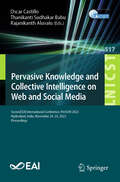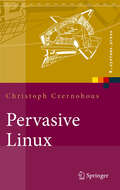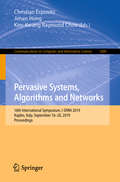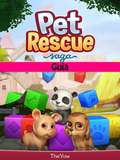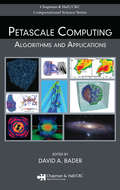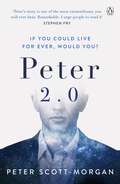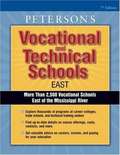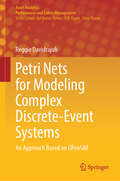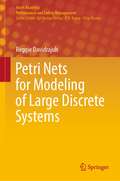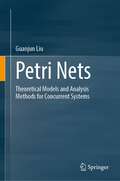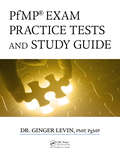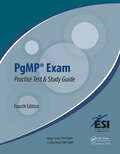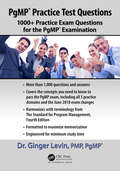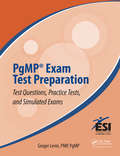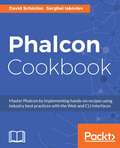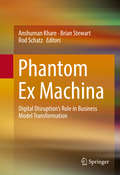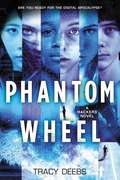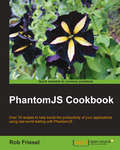- Table View
- List View
Pervasive Knowledge and Collective Intelligence on Web and Social Media: Second EAI International Conference, PerSOM 2023, Hyderabad, India, November 24–25, 2023, Proceedings (Lecture Notes of the Institute for Computer Sciences, Social Informatics and Telecommunications Engineering #517)
by Oscar Castillo Rajanikanth Aluvalu Thanikanti Sudhakar BabuThis book constitutes the refereed proceedings of the Second EAI International Conference on Pervasive Knowledge and Collective Intelligence on Web and Social Media, PerSOM 2023, which took place in Hyderabad, India, during November 24–25, 2023. The 28 full papers included in the proceedings were carefully reviewed and selected from 70 submissions. They focus on information and Web mining, social network analysis, semantic network analysis, trust, reputation, social control and privacy, information reliability, and Web and content authenticity.
Pervasive Linux
by Christoph CzernohousDer Band bietet eine grundlegende Einführung in das Thema Linux für mobile Endgeräte wie z. B. PDAs (Personal Digital Assistants) oder Mobiltelefone. Der Autor erläutert zunächst die Spezifika sogenannter eingebetteter Systeme und erklärt dann, was beim Einsatz von Linux als Betriebssystem zu beachten ist. Anschließend werden die zentralen Komponenten eines Linux-Systems vorgestellt und die Programmierung unter Linux mithilfe gängiger Werkzeuge im Detail dargelegt. Berücksichtigt wird insbesondere die Entwicklung von Benutzeroberflächen.
Pervasive Mobile and Ambient Wireless Communications
by Alberto Zanella Roberto VerdonePervasive Mobile and Ambient Wireless Communications reports the findings of COST 2100, a project of the European intergovernmental COST framework addressing various topics currently emerging in mobile and wireless communications. Drawing on experience developed in this and earlier COST projects, the text represents the final outcome of collaborative work involving more than 500 researchers in 140 institutions and 30 countries (including outside Europe). The book's subject matter includes: transmission techniques; signal processing; radio channel modelling and measurement; radio network issues; and recent paradigms including ultra-wideband, cooperative, vehicle-to-vehicle and body communications. The research reported comes from a variety of backgrounds: academic, equipment-manufacturing and operational and the information contained in this book will bring the study reported to a wider audience from all those spheres of work. Pervasive Mobile and Ambient Wireless Communications will be of interest to researchers for its cutting-edge analysis and to practitioners for its functional usability.
Pervasive Social Computing
by Muhammad Ashad Kabir Jun Han Alan ColmanThis book presents a review of traditional context-aware computing research, identifies itslimitations in developing social context-aware pervasive systems, andintroduces a new technology framework to address these limitations. Thus, thisbook provides a good reference for developments in context-aware computing andpervasive social computing. It examines the emerging area of pervasive social computing, which is a novel collective paradigm derived from pervasive computing, social media, social networking, social signal processing and multimodal human-computer interaction. This book offers a novel approach tomodel, represent, reason about and manage different types of social context. Itshows how users' social context information can be acquired from differentonline social networks such as Facebook, LinkedIn, Twitter and Google Calendar. It further presents the use of social context information in developinginnovative smart mobile applications to assist users in their daily life. Themix of both theoretical and applied research results makes this book attractiveto a variety of readers from both academia and industry. This book provides a new platform forimplementing different types of socially-aware mobile applications. Theplatform hides the complexity of managing social context, and thus providesessential support to application developers for the development ofsocially-aware applications. The book contains detailed descriptions of how theunderlying platform has been implemented using available technologies such asontology and rule engines, and how this platform can be used to develop socially-aware mobile applications using two exemplar applications. The bookalso presents evaluations of the proposed platform and applications using real-worlddata from Facebook, LinkedIn and Twitter. Therefore, this book is a syndicationof scientific research with practical industrial applications, making it usefulto researchers as well as to software engineers.
Pervasive Systems, Algorithms and Networks: 16th International Symposium, I-SPAN 2019, Naples, Italy, September 16-20, 2019, Proceedings (Communications in Computer and Information Science #1080)
by Kim-Kwang Raymond Choo Christian Esposito Jiman HongThis book constitutes the refereed proceedings of the 16th International Symposium on Pervasive Systems, Algorithms and Networks, I-SPAN 2019, held in Naples, Italy, in September 2019. The 32 full papers and 8 short papers were carefully reviewed and selected from 89 submissions. The papers focus on all aspects of: big data analytics & machine learning; cyber security; cloud fog & edge computing; communication solutions; high performance computing and applications; consumer cyber security; and vehicular technology.
Pervasive Wireless Environments: Detecting and Localizing User Spoofing
by Jie Yang Yingying Chen Wade Trappe Jerry ChengThis Springer Brief provides a new approach to prevent user spoofing by using the physical properties associated with wireless transmissions to detect the presence of user spoofing. The most common method, applying cryptographic authentication, requires additional management and computational power that cannot be deployed consistently. The authors present the new approach by offering a summary of the recent research and exploring the benefits and potential challenges of this method. This brief discusses the feasibility of launching user spoofing attacks and their impact on the wireless and sensor networks. Readers are equipped to understand several system models. One attack detection model exploits the spatial correlation of received signal strength (RSS) inherited from wireless devices as a foundation. Through experiments in practical environments, the authors evaluate the performance of the spoofing attack detection model. The brief also introduces the DEMOTE system, which exploits the correlation within the RSS trace based on each device's identity to detect mobile attackers. A final chapter covers future directions of this field. By presenting complex technical information in a concise format, this brief is a valuable resource for researchers, professionals, and advanced-level students focused on wireless network security.
Pet Photography 101: Tips for taking better photos of your dog or cat
by Andrew DarlowAre you one of the 100 million people in the USA that own either a dog or a cat? If you flip through your digital camera - what do you see pictures of the most? Your kids...and your pets! If you have ever wondered how to take pictures of an all black animal or how to get your pup to sit still during a family holiday picture, this book is for you. With love only a pet owner can have and humor that only animals can bring to us, this author shows how to take pictures that celebrate the furry creatures in our lives. Packed with techniques including lighting and postproduction and even info on getting those pictures up online, you'll be taking pictures of your pets that you'll be proud of.
Pet Rescue Saga Guia
by Joshua Abbott Bianca Regina PaganiniEste Guia ajudará os jogadores do jogo Pet Rescue Saga a aprender hacks para aproveitarem o jogo ainda mais. Nele há dicas sobre os boosters e hacks sobre eles e sobre vidas ilimitadas. Também apresenta links de vídeo de cada nível do jogo para ajudar ainda mais os jogadores. Com certeza quem gosta de Pet Rescue Saga não pode deixar de ter este Guia.
Petascale Computing: Algorithms and Applications
by David A. BaderAlthough the highly anticipated petascale computers of the near future will perform at an order of magnitude faster than today's quickest supercomputer, the scaling up of algorithms and applications for this class of computers remains a tough challenge. From scalable algorithm design for massive concurrency toperformance analyses and scientific vis
Peter 2.0: The Human Cyborg
by Peter Scott-MorganThe incredible book behind the primetime Channel 4 documentary, Peter: The Human Cyborg'A remarkable account of what it means to be human and what technology can really achieve' Sunday Telegraph'Peter's story is one of the most extraordinary you will ever hear. I urge people to read it' Stephen Fry'A remarkable story . . . you're left desperate to take nothing for granted' Radio Times __________ Peter, a brilliant scientist, is told that he will lose everything he loves. His husband. His family. His friends. His ability to travel the world. All will be gone. But Peter will not give up. He vows that this will not be the end and instead seeks a completely new beginning . . . Peter has Motor Neurone Disease, a condition universally considered by doctors to be terminal. He is told it will destroy his nerve cells and that within about two years, it will take his life too. But, face-to-face with death, he decides there is another way. Using his background in science and technology, he navigates a new path, one that will enable him not just to survive, but to thrive. This is the astonishing true story about Peter Scott-Morgan: the first person to combine his very humanity with artificial intelligence and robotics to become a full Cyborg. His discovery means that his terminal diagnosis is negotiable, something that will rewrite the future.And change the world. By embracing love, life and hope rather than fear, tragedy and despair, he will become Peter 2.0. __________'Compelling . . . Scott-Morgan is a true one-off. It is in the telling of the love story, rather than the technical details of becoming a cyborg, that this book succeeds' The Times 'What's striking is Peter's constant optimism, bravery and his ability to find radical answers to problems that have confounded Britain's brightest minds' Daily Telegraph 'A soaring love story' Financial Times 'Fascinating and extremely moving' Sun
Peterson's Vocational and Technical Schools East (7th Edition)
by Peterson'sA guide book for users to compare the vocational programs in East side of the United States that offer training for many of today's hottest jobs.
Peterson's Vocational and Technical Schools West (7th Edition)
by Peterson'sA guide book for readers to compare the vocational programs in the Western United States that offer training for many of today's hottest jobs.
Petri Nets for Modeling Complex Discrete-Event Systems: An Approach Based on GPenSIM (Asset Analytics)
by Reggie DavidrajuhThis book addresses the need for users to understand the internal workings of GPenSIM's functions, including their design and how they can be extended to model and analyze scenarios that were previously not possible. It presents previously unavailable internal details of these functions, demonstrating how systems that could not be modeled in the past can now be analyzed by extending the capabilities of the GPenSIM tool. This book concentrates on the internal mechanics of the GPenSIM tool, specifically aimed at benefiting tool developers and designers. GPenSIM is a tool for modeling discrete systems, widely used in many universities around the world. The author of this book developed GPenSIM, which has been utilized to model various practical scenarios. Users often seek to understand the inner workings of GPenSIM, such as its design and its integration with other tools. This book addresses these aspects and acts as a reference manual for GPenSIM, helping users quickly grasp the various ways to utilize its functions and how these can be tailored to specific cases. One of the notable features of GPenSIM is its tight integration with MATLAB. This not only facilitates easy deployment and operation but also allows users to leverage MATLAB's extensive libraries for practical applications across various fields. The details provided in this book, along with its structured format, will greatly assist both university students and practicing engineers.
Petri Nets for Modeling of Large Discrete Systems (Asset Analytics)
by Reggie DavidrajuhThis book offers a new Modular Petri Net as a solution to the vast Petri net models. It presents some approaches centering around modules (known as “Petri modules”). The goal of this book is to introduce a methodology in which Petri nets are moved to a new level. In this new level, large Petri net models are made of Petri modules, which are independent and run on different computers. This book also contains the literature study on modular Petri nets and definitions for the newer Petri modules. Also, algorithms for extracting Petri modules, and algorithms for connecting Petri modules, and applications are given in this book. Besides, the ideas and algorithms given in this book are implemented in the software General-purpose Petri Net Simulator (GPenSIM). Hence, with the use of this book the readers/users would be able to know that real-life discrete event systems could be modeled, analyzed, and performance-optimized with GPenSIM.
Petri Nets: Theoretical Models and Analysis Methods for Concurrent Systems
by Guanjun LiuThis book provides essential information on Petri net theory and Petri net-based model checking methods. As for the Petri net theory, it involves the interleaving semantics and concurrency semantics of elementary net systems, some important net structures (e.g., invariant, repetitive vector, siphon, and trap), some classical net subclasses with special structures (e.g., state machine, marked graph, free-choice net,asymmetric-choice net, normal net, and weakly persistent net), and some basic properties (e.g., reachability, liveness, deadlock, and soundness). It also involves four high-level Petri nets: knowledge-oriented Petri nets, Petri nets with insecure places, time Petri nets, and plain time Petri nets with priorities, focusing on different fields of application. As for the model checking methods, this book introduces readers to computation tree logic (CTL), computation tree logic of knowledge (CTLK), and timed computation tree logic (TCTL), as well as Petri net-based methods for checking them. The basic principle of the reduced ordered binary decision diagram (ROBDD) is employed to compress the state space used in these model checking procedures. The book also covers time-soundness for time Petri nets and secure bisimulation for Petri nets with insecure places, both of which are based on the bisimulation theory. As such, it offers an introduction to basic information on bisimulation theory.
PfMP Exam Practice Tests and Study Guide (Best Practices in Portfolio, Program, and Project Management)
by PMP, PgMP, LevinRecognizing the importance of portfolio management, the Project Management Institute (PMI) has launched a new certification entitled the Portfolio Management Professional (PfMP). PfMP Exam Practice Tests and Study Guide is the most comprehensive resource available to help you prepare for and pass the PfMP certification exam. It provides covera
PgMP Exam Challenge! (ESI International Project Management Series #17)
by Ginger Levin PMP PgMP J. LeRoy Ward PMP PgMPUp to date with the third edition of PMI's Program Management Standard, The PgMP Exam Challenge! contains more than 300 practice questions to help readers hone their knowledge and test their skills. It covers all five of the program management domains: Strategic Program Management, Program Management Life Cycle, Benefits Management, Stakeholder Management, and Governance. It also examines all of the sub domains of the lifecycle domain. With an easy-to-use format, this is an ideal resource for those preparing to take the PgMP exam.
PgMP Exam Practice Test and Study Guide (ESI International Project Management Series)
by Ginger Levin J. LeRoy WardUp to date with the third edition of PMI's Standard for Program Management, this is the most comprehensive resource available to help prepare readers for the PgMP Exam. Updated with new and changed terminology, this edition incorporates the concepts from the five performance domains. The book features practical study hints, a list of major topics covered on the exam, and a bibliographic reference for further study. The two challenging, 170-question practice tests are available in the book and online so readers can retake the practice tests as many times necessary.
PgMP Practice Test Questions: 1000+ Practice Exam Questions for the PgMP Examination
by Ginger LevinUp to date with the fourth edition of PMI’s Program Management Standard, PgMP® Practice Test Questions: 1000+ Practice Exam Questions for the PgMP® Examination contains more than 1,000 practice questions to help readers hone their knowledge and test their skills. It covers all five of the program management domains: Strategic Program Management, Program Management Life Cycle, Benefits Management, Stakeholder Management, and Governance. It also examines all of the sub domains of the lifecycle domain. With an easy-to-use format, this is an ideal resource for those preparing to take the PgMP® exam.
PgMP® Exam Test Preparation: Test Questions, Practice Tests, and Simulated Exams (Best Practices in Portfolio, Program, and Project Management)
by Pmp Ginger Levin PgMPIn addition to test questions in each of the five domains and two practice tests in print and online, this all-in-one study guide also contains flashcards for learning terms. This book is current with The Standard for Program Management, Fourth Edition, and its author is the second person in the world to have earned the PgMP® certification. The online versions of the practice test simulate taking the actual exams and provide scoring as above target, target, below target, or needs improvement. Answers come with explanations and references. Questions are written to improve reading skills and teach how to select the best answer, which are key to passing the exam.
Phalcon Cookbook
by David Schissler Serghei IakovlevMaster Phalcon by implementing hands-on recipes using industry best practices with the Web and CLI interfaces About This Book * Create quick prototypes with the Phalcon Developer Tools * Learn to use the powerful and uniquely efficient Phalcon ORM * Reuse codes in real projects Who This Book Is For If you are a beginner-to-intermediate Phalcon developer who wants to level up or an advanced user who is seeking some new techniques and insight, then this book is perfect for you. This book will be relevant to you over a long period of time due to the mixed nature of this book in providing both abstract comprehension as well as specific examples meant to be usable in your projects. You will be able to experiment with each new aspect of integration in prebuilt recipes meant to best illustrate each specific feature. This will save you lots of time getting up to speed before attempting to integrate into a real application. What You Will Learn * Install the Phalcon extension from both premade packages and source code * Create a normal and micro application structure * Understand the dispatcher event cycle and create custom plugins * Get hands-on using the Phalcon Query Language and ORM * Create flexible views with the Volt template system * Leverage Phalcon to prevent common security vulnerabilities * Optimize an application with focused solutions * Profile and debug an application to get increased reliability In Detail Phalcon is a high-performance PHP framework delivered as a PHP extension. This provides new opportunities for speed and application design, which until recently have been unrealized in the PHP ecosystem. Packed with simple learning exercises, technology prototypes, and real-world usable code, this book will guide you from the beginner and setup stage all the way to advanced usage. You will learn how to avoid niche pitfalls, how to use the command-line developer tools, how to integrate with new web standards, as well as how to set up and customize the MVC application structure. You will see how Phalcon can be used to quickly set up a single file web application as well as a complex multi-module application suitable for long-term projects. Some of the recipes focus on abstract concepts that are vital to get a deep comprehension of Phalcon and others are designed as a vehicle to deliver real-world usable classes and code snippets to solve advanced problems. You'll start out with basic setup and application structure and then move onto the Phalcon MVC and routing implementation, the power of the ORM and Phalcon Query Language, and Phalcon's own Volt templating system. Finally, you will move on to caching, security, and optimization. Style and approach An easy-to-start guide that provides
Phantom Ex Machina
by Anshuman Khare Brian Stewart Rod SchatzThis book explores the factors that make digital disruption possible and the effects this has on existing business models. It takes a look at the industries that are most susceptible to disruption and highlights what executives can do to take advantage of disruption to re-invent their business model. It also examines the pivotal role that technology plays in creating new dynamics to business operations and forcing business model changes. Adoption of digital technology has caused process disruptions in a number of industries and led to new business models (e. g. , #65533;ber, AirBnb) and new products. In addition to covering some of the more popular and well known examples, this book targets not so obvious disruptions in the education sector and in services and changing business models. Phantom Ex Machina: Digital Disruption's Role in Business Model Transformation is divided into six parts. The book begins with an introduction to digital disruption and why it matters. The next part of the book focuses on business strategy which includes case studies on the impact of social media and how digital disruption changes pricing strategies and price models. For part three, the authors observe technology's role in digital disruptions. Chapters cover how 3D printing is challenging existing business models and how the automotive industry is innovating with new perspectives. Part four covers higher education, recognizing digital disruption's transformation in graduate management education. Part five centers upon the service industry with a look at virtual teams and the emergence of virtual think tanks. Finally the book concludes with a look to the future, embracing disruptions.
Phantom Wheel: A Hackers Novel
by Tracy DeebsThe digital apocalypse has arrived and the future is here in this addictive technological thriller full of twists and turns. Perfect for fans of Nerve! Being recruited by the CIA to join a top-secret intelligence program should be the opportunity of a lifetime. For Issa, it's a shot at creating a new and better life for herself and her siblings. For clever con artist Harper, it's a chance to bury the secrets of her troubled past and make sure that those secrets stay buried. But for Owen--honor student, star quarterback, and computer-hacking genius--it sounds like a trap. He's right. Owen discovers that instead of auditioning for the CIA, they've all been tricked by a multibillion-dollar tech company into creating the ultimate computer virus. It's called Phantom Wheel, and it's capable of hacking anyone on Earth, anywhere, at any time. And thanks to six teenagers, it's virtually unstoppable. Horrified by what they've done, the hackers must team up to stop the virus before the world descends into chaos. But working together is easier said than done, especially as the lines start to blur between teammate, friend, and more than friend. Because how do you learn to trust someone when you've spent your entire life exploiting that same trust in others?
PhantomJS Cookbook
by Rob FrieselA task-based guide that provides solutions to real-world test automation problems. This book is intended for web development professionals who want to integrate PhantomJS into their development and testing workflows. If you are a web developer looking to run automated unit tests while you work, or perhaps you are a QA engineer looking for a fast test automation utility, then this book is perfect for you. Some prior knowledge of JavaScript would be helpful.
